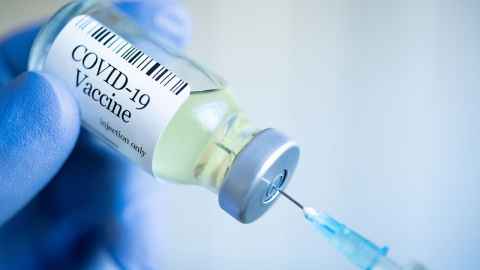How the Pfizer vaccine for Covid-19 works
24 February 2021
Opinion: With the roll-out of a Covid-19 vaccine gathering steam across New Zealand, here’s a quick explainer from Associate Professor Siouxsie Wiles on what goes into it and how it works.

Who is getting vaccinated?
First on the list to be offered the vaccine are the people working at the border and within the managed isolation and quarantine (MIQ) system and their families. They are the ones most at risk of contracting Covid-19 in New Zealand.
What are they getting vaccinated with?
There are three main strategies for making a vaccine: using a whole microbe, using the parts of the microbe that the immune system recognises, or using the genetic material that codes for the parts of the microbe that the immune system recognises. New Zealand has four vaccines in its portfolio to cover each of these different approaches.
The vaccine currently being rolled out to border and MIQ vaccines is the Pfizer/BioNTech messenger RNA (mRNA) vaccine known as Comirnaty™ or BNT162b2. This vaccine contains a synthetic version of the genetic material that codes for the SARS-CoV-2 spike protein.
What are the ingredients of the Pfizer/BioNTech mRNA vaccine?
You can check out the pdf of the Consumer Medicine Information summary for the Comirnaty™/BNT162b2 vaccine from Medsafe here. The active ingredient of the vaccine is 30 µg of a nucleoside modified mRNA which codes for the spike (S) glycoprotein of the SARS-CoV-2 virus.
The vaccine also contains fats which make up the lipid nanoparticle coat which helps to transport the mRNA into our cells without it being broken down. These fats are:
- (4 hydroxybutyl)azanediyl)bis(hexane-6,1-diyl)bis(2-hexyldecanoate) – 0.43 mg
- 2[(polyethylene glycol)-2000]-N,N-ditetradecylacetamide – 0.05 mg
- 1,2-distearoyl-sn-glycero-3- phosphocholine – 0.09 mg
- Cholesterol – 0.2 mg
The vaccine also contains salts to ensure its pH is similar to that of human cells. These salts are:
- Potassium chloride – 0.01 mg
- Mg monobasic potassium phosphate – 0.01 mg
- Mg sodium chloride – 0.36 mg
- Dibasic sodium phosphate dihydrate – 0.07 mg
The final ingredient of the vaccine is 6 mg of sucrose, which is a sugar that is added to protect the lipid nanoparticle coat at the very cold temperatures the vaccine is stored at (-80 degrees C).
How does the Pfizer/BioNTech mRNA vaccine work?
Before explaining how the vaccine works, we need to quickly lay out how our cells make proteins. Our genetical material is in the form of DNA which sits inside a special compartment in our cells called the nucleus. When a gene is turned on, its DNA is copied into mRNA. This process is called transcription. The mRNA then makes a one-way trip out of the nucleus and into the main body of the cell, known as the cytoplasm. In the cytoplasm are the ribosomes, which take the mRNA and build a protein out of the message it contains. This process is called translation.
The Pfizer/BioNTech vaccine is made up of the mRNA that codes for the virus’s spike protein, wrapped up in a lipid coat to protect it. When it’s injected into our body, the lipid coat helps the mRNA get taken up by some of the cells that are hanging around in our arm. Once inside the cytoplasm of the cells, the mRNA is unwrapped from its lipid coat and used by our ribosomes to make the spike protein. Because the vaccine is made of mRNA and not DNA it isn’t able to get into our nucleus to interfere with our DNA. In other words, it is only the translation part of the process that can happen.
Once the spike protein is made, the cell destroys the mRNA, so it probably only hangs around for a few hours or days. The cell also chops up the spike protein and displays the pieces on its surface for our immune cells to see. That triggers our immune response which trains our immune cells to recognise the spike protein and so destroy the real SARS-Cov-2 virus if they see it in the future.
Why are there two doses of the vaccine?
The first dose of the vaccine “primes” the immune system. It’s the body’s first opportunity to see the foreign material and mount an immune response. In some people that first response isn’t very strong and doesn’t last very long, so the second dose is a “booster” dose to ensure the immune response is stronger and longer-lasting. That’s also why some people can have more side effects after their second dose.
Why does it need to be stored at such a low temperature?
Basically, to stop it from falling apart and the mRNA degrading. Chemical reactions happen more slowly at low temperatures so the lower the temperature the longer the vaccine will be stable for. The way a company finds out how stable its products are is by storing them at different temperatures for different amounts of time. These studies will still be ongoing. Pfizer has just reportedly submitted some data to the US FDA regulator which suggests their vaccine could be stored at between -15 and -25 for two weeks, which would make the rollout easier.
Associate Professor Siouxsie Wiles is a microbiologist from the Department of Molecular Medicine and Pathology in the Faculty of Medical and Health Sciences' School of Medical Sciences.
This article reflects the opinion of the author and not necessarily the views of the University of Auckland.
Used with permission from The Spinoff, Siouxsie Wiles & Toby Morris: How the Pfizer vaccine for Covid-19 works, 24 February 2021
Media contact
Paul Panckhurst | Media Adviser
Mobile: 022 032 8475
Email: paul.panckhurst@auckland.ac.nz